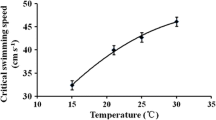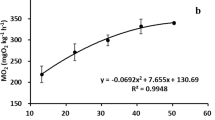Abstract
Tank wall collision is one of the major causes of mortality during the early-stage rearing of Pacific bluefin tuna, Thunnus orientalis (PBT). Therefore, to design a rearing environment that meets the needs of juvenile PBT, it is important to gather information about their swimming capabilities. We conducted experiments to examine the relative critical swimming speed (RCSS) and maximum sustainable swimming speed (MSSS) of early-stage PBT. The fish were kept in 3-tonne tanks and fed on artificial pellets every 2 h from dusk to dawn. We conducted two sets of experiments to measure swimming speed; the fish were introduced one at a time into a water funnel, and the water current velocity was gradually increased over time to estimate RCSS, or the water current was kept at a constant velocity to estimate MSSS. We measured the RCSS of 72 PBT juveniles (24–29 days after hatching (DAH); standard length (SL), 15.0 ± 2.3 mm) and the MSSS of 32 PBT juveniles (28–37 DAH; SL, 20.0 ± 5.1 mm) in the laboratory. The RCSS ranged from 4.7 to 20.3 SL/s (average, 12.4 ± 3.3 SL/s), and the MSSS was estimated to be approximately 4 SL/s. We speculate that introducing a water current in the rearing tank of no more than 4 SL/s could positively affect the survival of juvenile PBT.


Similar content being viewed by others
Abbreviations
- PBT:
-
Pacific bluefin tuna
- SL:
-
Standard length
- CSS:
-
Critical swimming speed
- RCSS:
-
Relative critical swimming speed
- MSSS:
-
Maximum sustainable swimming speed
- DAH:
-
Days after hatching
References
Alexander R (1982) Locomotion of animals. Blackie and Son, Glasgow
Bellwood DR, Fisher R (2001) Relative swimming speeds in reef fish larvae. Mar Ecol Prog Ser 211:299–303
Berry CR Jr, Pimentel R (1985) Swimming performance of three rare Colorado River fishes. Trans Am Fish Soc 114:397–402
Fisher R, Wilson SK (2004) Maximum sustainable swimming speed of late-stage larvae of nine species of reef fishes. J Exp Mar Biol Ecol 312:171–186
Fukuda H, Torisawa S, Sawada Y, Takagi T (2010) Ontogenetic changes in schooling behavior during larval and early juvenile stages of Pacific bluefin tuna Thunnus orientalis. J Fish Biol 76:1841–1847
Ishibashi Y (2006) Collision death in seedling production. Nippon Suisan Gakkaishi 72:949–950 (in Japanese)
James MK, Armsworth PR, Mason LB, Bode L (2002) The structure of reef fish metapopulations: modeling larval dispersal and retention patterns. Proc Biol Sci 269:2079–2086
Jones DR, Kiceniuk JW, Bamford OS (1974) Evaluation of the swimming performance of several fish species from the MacKenzie River. J Fish Res Board Can 31:1641–1647
Kawamura G, Masuna S, Tezuka N, Koiso M, Jinbo T, Namba K (2003) Morphogenesis of sense organs in the bluefin tuna Thunnus orientalis. In: Abstracts of the Big Fish Bang proceedings of the 26th annual fish larval fish conference, Institute of Marine Research, Bergen, Norway, 22–26 July 2002
Komeyama K, Kadota M, Torisawa S, Suzuki K, Tsuda Y, Takagi T (2011) Measuring the swimming behavior of a reared Pacific bluefin tuna in a submerged aquaculture net cage. Aquat Living Resour 24:99–105
Miyashita S (2002) Studies on the seedling production of Pacific bluefin tuna, Thunnus orientalis. Bull Fish Lab Kinki Univ 8:1–173 (in Japanese with English abstract)
Miyashita S, Sawada Y, Hattori N, Nakatsukasa H, Okada T, Murata O, Kumai H (2000) Mortality of northern bluefin tuna Thunnus thynnus due to trauma caused by collision during growout culture. J World Aqua Soc 31:632–639
Miyashita S, Sawada Y, Okada T, Murata O, Kumai H (2001) Morphological development and growth of laboratory-reared larval and juvenile Thunnus thynnus (Pisces: Scombridae). Fish Bull 99:601–616
Myrick CA, Cech JJ (2000) Swimming performance of four California stream fishes: temperature effects. Environ Biol Fish 58:289–295
Plaut I (2001) Critical swimming speed: its ecological relevance. Comp Biochem Physiol A Mol Integr Physiol 131:41–50
Sabate FS, Sakakura Y, Takebe T, Nikaido H, Matsumoto N, Shiozawa S, Hagiwara A, Masuma S (2009) Preliminary observations on the development of aggressive behavior in Pacific bluefin tuna Thunnus orientalis. Aqua Sci 57:329–335
Sawada Y (2006) Morphological development and organogenesis of Pacific bluefin tuna Thunnus orientalis. Nippon Suisan Gakkaishi 72:945–946 (in Japanese)
Sawada Y, Miyashita S, Aoyama M, Kurata M, Mukai Y, Okada T, Murata O, Kumai H (2000) Rotifer-size selectivity and optimal feeding density of bluefin tuna, Thunnus thynnus, larvae. Suisanzoshoku 48:169–177
Sawada Y, Okada T, Miyashita S, Murata O, Kumai H (2005) Completion of the Pacific bluefin tuna Thunnus orientalis (Temminck et Schlegel) life cycle. Aqua Res 36:413–421
Acknowledgments
This work was supported by a grant to F.S.S. from the Global COE program from the Ministry of Education, Culture, Science, Sports and Technology (International Education and Research Center for Aquaculture Science of Bluefin Tuna and Other Cultured Fish), Japan. The authors thank the staff of the Amami Experiment Station and the Shirahama Station Fish Nursery Center for their support during our experiments.
Author information
Authors and Affiliations
Corresponding author
Rights and permissions
About this article
Cite this article
de la S. Sabate, F., Nakagawa, Y., Nasu, T. et al. Critical swimming speed and maximum sustainable swimming speed of juvenile Pacific bluefin tuna, Thunnus orientalis . Aquacult Int 21, 177–181 (2013). https://doi.org/10.1007/s10499-012-9543-3
Received:
Accepted:
Published:
Issue Date:
DOI: https://doi.org/10.1007/s10499-012-9543-3




